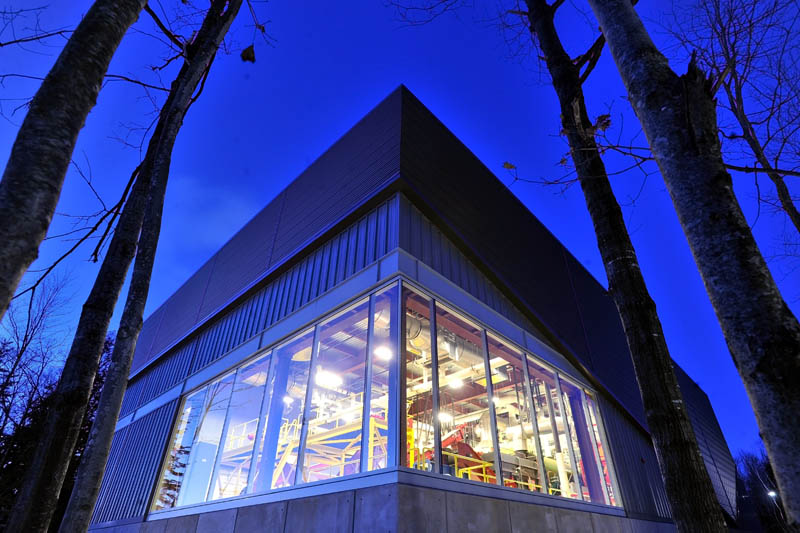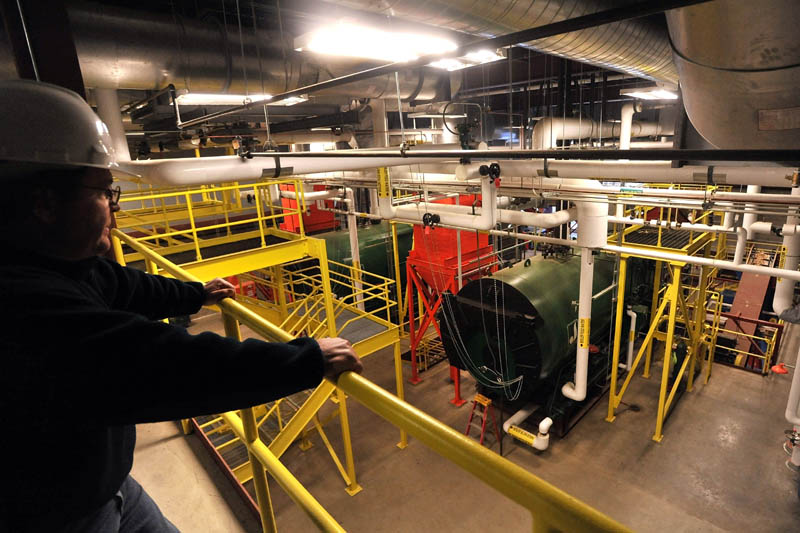WATERVILLE — A new $11.25 million biomass plant at Colby College is now in operation, with officials expecting it will save the college about $1.5 million a year in heating costs.
The 8,100-square-foot biomass plant on Campus Drive burns forestry products, including wood chips, bark, branches and treetops, producing steam that is distributed underground to all parts of the campus.
“It’s exciting,” said Patricia Whitney, director of Colby’s physical plant. “And with these bitter cold temperatures, it couldn’t have come at a better time.”
Two huge 400-horsepower boilers inside the plant produce steam used not only for heat, but also for hot water, cooking and co-generation of electricity on campus. The plant will replace 90 percent of the 1.1 million gallons of heating oil Colby has used every year, according to Colby spokeswoman Ruth Jacobs.
The wood used in the plant is provided by Cousineau Forest Products and comes from sustainable forest operations within a 50-mile radius of campus.
Whitney said it is wood that otherwise would be left on the forest floor.
Whitney and Brian Boutin, superintendent of PC Construction, also known as Pizzagalli Construction, the general contractor for the project explained the process in a tour of the plant Thursday.
During the coldest part of the year, about four trucks a day arrive and dump wood inside the plant. The wood is moved to conveyor belts and if the particles are too large, they are re-sized. The wood then goes into a gasifier.
“It’s like a burner — it blows heat into the boiler, where steam is made,” Boutin said.
“We have two boilers, two conveyors and two resizers, so if we have a major problem, we don’t have to shut down,” Whitney said.
The gasification combustion system is from Chiptec Wood Energy Systems, of Williston, Vt. The system burns the gas, resulting in cleaner emissions, she said. Dust collectors and a $480,000 electrostatic precipitator minimize pollutants entering the atmosphere.
The plant was built to Leadership in Energy and Environmental Design specifications, and is expected to receive at least a LEED certification from the U.S. Green Building Council.
Four people operate the plant, which is monitored 24 hours a day, seven days a week.
More than 75 short-term jobs were created to build the plant, according to Jacobs. The college’s use of biomass is expected to create four or five permanent jobs in the state’s forestry industry. The plant is also a key part of Colby’s plan to become carbon neutral by 2015, Jacobs said.
The corner of the building facing campus is all glass, so that people outside can watch it operate. Students can also study biomass operations at the plant.
Boutin said some people have asked about the plant’s emissions.
“What you see coming out of the stack is not smoke — it’s actually water vapor,” he said.
In an attempt to minimize waste, the college is working with a company that uses ash, which the plants produces, for composting, according to Whitney.
The plant replaces about 1 million gallons of heating fuel annually with about 22,000 tons of local wood.
Construction began on the plant in the fall of 2010. Colby was awarded a $750,000 grant from Efficiency Maine as part of a competitive grants program for large greenhouse gas reduction projects.
The plant, designed by ARC/Architectural Resources Cambridge, of Cambridge, Mass., was added on to the college’s physical plant, increasing the size of the building to 15,800-square feet. The design engineer was Rist Frost Shumway of Laconia, N.H.
Colby will continue to co-generate electricity in the plant, which uses about 1.1 million gallons of No. 6 (low sulfur) fuel oil annually. The biomass plant will replace 90 percent of that 1.1 million gallons, according to Jacobs.
Whitney said the idea for building the biomass plant came from Gus Libby, a mechanical engineer who works for Colby. Five or six years ago, the college got a scare when it became difficult to secure an adequate amount of oil, Whitney said.
“Gus realized it was really a problem for us, having only one source of fuel, and started looking at alternatives,” she said.
Whitney, who is a civil engineer, said that many times during the year, the campus will use only wood for fuel; it will supplement operations with oil when needed, such as in the coldest parts of the winter.
Officials predict, considering estimates of oil and wood biomass, that the plant will pay for itself in six to 10 years.
Amy Calder — 861-9247
acalder@centralmaine.com
Send questions/comments to the editors.





Success. Please wait for the page to reload. If the page does not reload within 5 seconds, please refresh the page.
Enter your email and password to access comments.
Hi, to comment on stories you must . This profile is in addition to your subscription and website login.
Already have a commenting profile? .
Invalid username/password.
Please check your email to confirm and complete your registration.
Only subscribers are eligible to post comments. Please subscribe or login first for digital access. Here’s why.
Use the form below to reset your password. When you've submitted your account email, we will send an email with a reset code.